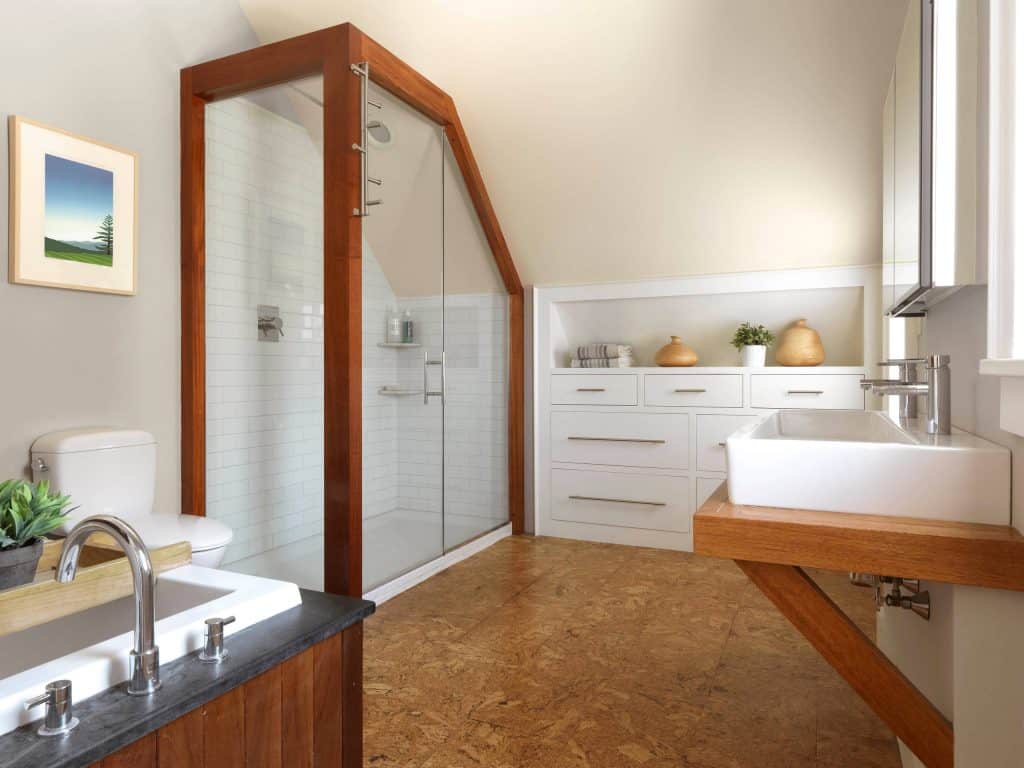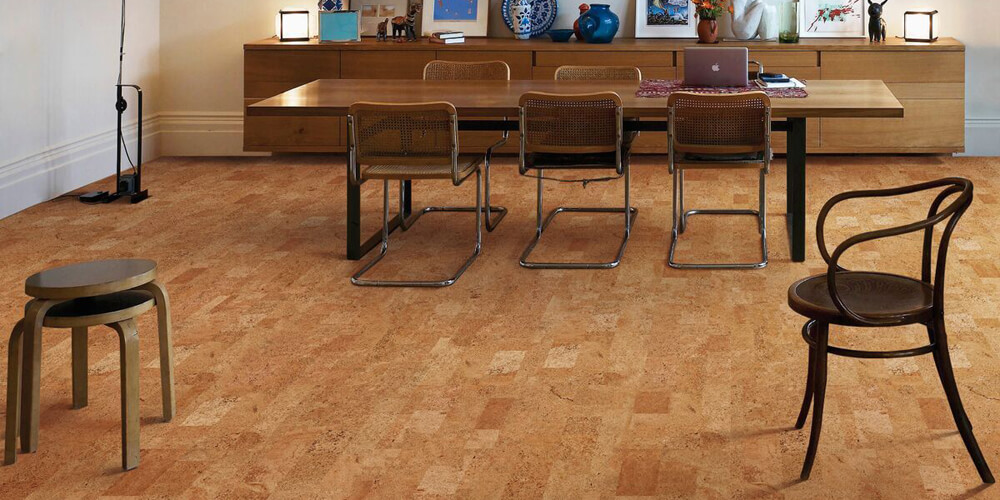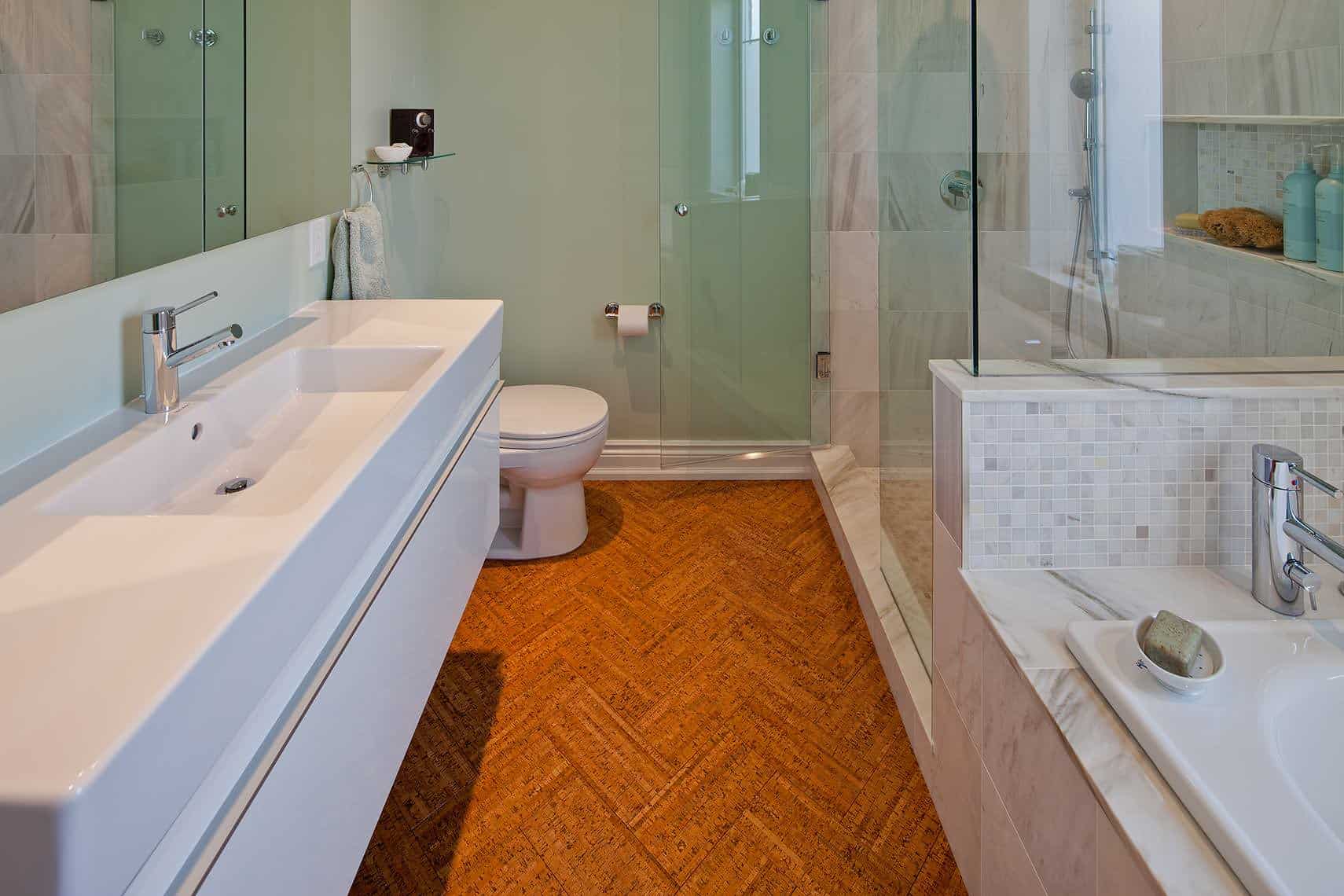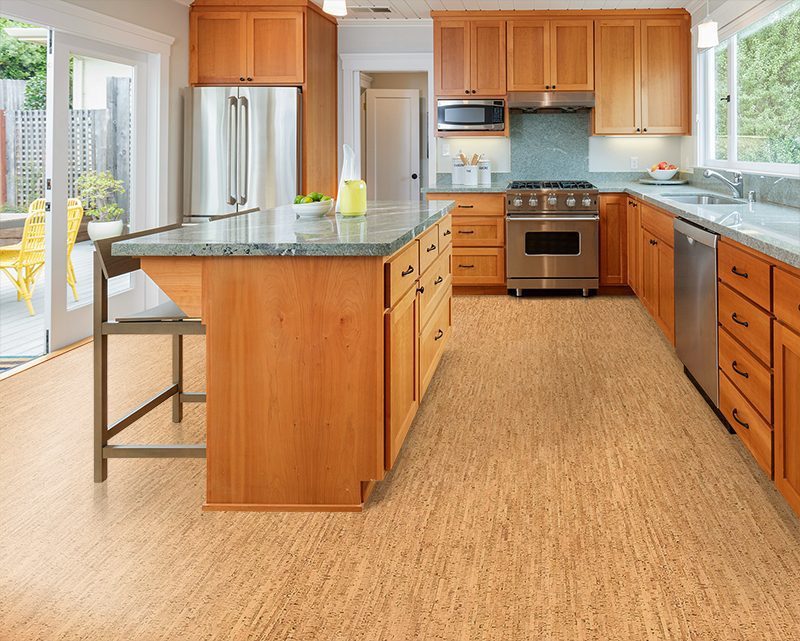The Water-Resistant Properties of Cork Flooring
Cork flooring has gained popularity in recent years due to its many benefits, including its water-resistant properties. Let’s explore why cork flooring is considered water-resistant and how it can be a great choice for areas prone to moisture.
- Natural Cork Composition: Cork is derived from the bark of the cork oak tree and is known for its unique cellular structure. It consists of millions of tiny air-filled cells, which act as natural insulators and make cork flooring resistant to water penetration. These cells also provide cushioning and thermal insulation, making cork flooring comfortable and energy-efficient.
- Protective Finishes: To enhance its water-resistant properties, cork flooring is often treated with protective finishes. These finishes create a barrier that prevents water from seeping into the cork material. Common finishes include polyurethane and wax coatings, which not only help repel water but also add durability and longevity to the flooring.
- Water Resistance vs. Waterproof: While cork flooring is water-resistant, it’s important to note that it is not completely waterproof. It can withstand occasional spills and moisture exposure, but prolonged contact with water can still cause damage. It’s crucial to understand the limitations of cork flooring in wet areas to prevent any potential issues.
- Installation Considerations: Proper installation is key to maximizing the water-resistant properties of cork flooring. It should be installed in areas with low humidity and moisture levels. Additionally, using a moisture barrier, such as a vapor retarder, under the cork flooring can provide an extra layer of protection against water vapor transmission from the subfloor.
- Maintenance: To maintain the water-resistant qualities of cork flooring, it’s essential to clean up spills promptly and avoid excessive water exposure. Regular sweeping or vacuuming with a soft-bristle attachment should be done to remove dirt and debris. Avoid using excessive water or harsh cleaning agents, as they can damage the protective finish and compromise the water resistance of the flooring.

Understanding the Limitations of Cork Flooring in Wet Areas
While cork flooring is known for its water-resistant properties, it does have limitations when it comes to wet areas. Here are factors that can impact cork flooring’s performance in wet environments and understand when it may not be the best choice.
- Moisture Absorption: Although cork flooring is naturally resistant to water, it can still absorb moisture if exposed to excessive amounts. High humidity levels or prolonged water contact can cause the cork to swell or warp, leading to potential damage. This makes cork flooring less suitable for areas such as bathrooms or basements with high moisture levels.
- Seams and Joints: Cork flooring typically comes in planks or tiles that are installed with seams and joints. These areas can be vulnerable to water penetration if not properly sealed or maintained. If water seeps into the seams, it can cause the cork to expand or create a breeding ground for mold and mildew. This makes it crucial to ensure proper sealing and regularly inspecting the flooring for any signs of water damage.
- Subfloor Preparation: The condition of the subfloor is essential when installing cork flooring in wet areas. Moisture-prone subfloors, such as concrete, should be properly sealed and tested for moisture content before installation. Inadequate subfloor preparation can lead to moisture seeping up through the subfloor and affecting the cork flooring.
- Heavy Water Exposure: Cork flooring should not be installed in areas with heavy water exposure, such as showers or outdoor spaces. Direct and continuous water contact can cause irreversible damage to the cork material and compromise the flooring’s integrity. In such cases, alternative flooring options specifically designed for wet environments should be considered.
- Regular Inspections: Regular inspections are crucial to identify any potential water damage or moisture-related issues with cork flooring in wet areas. Look out for signs of warping, discoloration, or mold growth. If any issues are detected, it’s important to address them promptly to prevent further damage and maintain the longevity of the flooring.
Tips for Protecting Cork Flooring from Water Damage
To ensure the longevity and durability of cork flooring in wet areas, it’s important to take proactive measures to protect it from water damage. Let’s explore some useful tips to safeguard your cork flooring and maintain its water-resistant properties.
Use Area Rugs or Mats: Placing area rugs or mats in areas prone to water exposure, such as near entryways or in front of sinks, can help protect the cork flooring. These rugs act as a barrier, absorbing excess moisture and preventing it from reaching the cork surface. Ensure that the rugs are made of water-resistant materials and are regularly cleaned to avoid trapping moisture underneath.
Wipe Up Spills Immediately: Promptly cleaning up spills is essential to prevent water from seeping into the cork flooring. Use a soft, absorbent cloth or paper towel to blot the spill, avoiding any rubbing or scrubbing that could push the liquid further into the cork. By addressing spills promptly, you can minimize the risk of water damage and maintain the integrity of the flooring.
Maintain Humidity Levels: Excess humidity can impact the performance of cork flooring in wet areas. Use a dehumidifier to regulate humidity levels, especially in basements or bathrooms. Aim for a relative humidity level of around 40-60% to prevent moisture-related issues. Regularly monitor humidity levels using a hygrometer to ensure optimal conditions for your cork flooring.
Seal the Seams and Joints: Properly sealing the seams and joints of cork flooring is crucial to prevent water penetration. Use a high-quality silicone-based seam sealer to seal any gaps or openings in the flooring. Regularly inspect the seams and reapply the sealer as needed. This extra layer of protection will help maintain the water-resistant properties of the cork flooring.
Avoid Excessive Water: When cleaning cork flooring in wet areas, it’s important to avoid excessive water usage. Instead of mopping with a wet mop, opt for a slightly damp mop or a microfiber cloth. Use a mild, pH-neutral cleaner specifically designed for cork flooring. Avoid using harsh chemicals or abrasive cleaners that can damage the protective finish and compromise the water resistance of the flooring.
Maintain Proper Ventilation: Good airflow and ventilation can help prevent moisture buildup and protect cork flooring in wet areas. Ensure that the space is well-ventilated, especially in areas such as bathrooms or basements. Use exhaust fans or open windows to promote air circulation and reduce the risk of excessive moisture and water damage.
Cleaning and Maintenance of Cork Flooring in Wet Environments
Proper cleaning and maintenance are essential to keep cork flooring in wet environments looking its best and maintaining its water-resistant properties. Let’s discuss some important cleaning and maintenance tips to ensure the longevity and performance of cork flooring in areas prone to moisture.
Regular Sweeping and Vacuuming: Regular sweeping or vacuuming with a soft-bristle attachment is key to removing dirt, dust, and debris from the cork flooring. This prevents scratches and abrasions that can compromise the water resistance and appearance of the flooring. Avoid using vacuums with beater bars, as they can cause damage to the cork surface.
Damp Mopping: Damp mopping is an effective way to clean cork flooring in wet environments. Use a well-wrung mop or a microfiber cloth dampened with water or a mild, pH-neutral cleaner specifically formulated for cork flooring. Avoid using excessive water, as it can seep into the seams and joints and cause damage. Always follow the manufacturer’s recommendations for cleaning products and techniques.
Immediate Spill Cleanup: Promptly cleaning up spills is crucial to prevent water damage to cork flooring. Use a soft, absorbent cloth or paper towel to blot the spill, avoiding any rubbing or scrubbing that could push the liquid further into the cork. If needed, use a mild, pH-neutral cleaner to remove any residue. Avoid using harsh chemicals or abrasive cleaners, as they can damage the protective finish.
Avoid Excessive Moisture: Cork flooring in wet environments should not be exposed to excessive moisture. Avoid using steam cleaners or wet mops that can introduce excessive water to the flooring. Instead, use a slightly damp mop or microfiber cloth for regular cleaning. If there is a need for a deeper cleaning, consult the manufacturer’s recommendations for specific cleaning methods.
Protecting Furniture and Heavy Objects: To avoid indentations and damage to the cork flooring, use furniture pads or coasters under heavy furniture or objects. These pads distribute the weight and minimize the risk of permanent marks or damage. Regularly check and replace pads as needed to ensure ongoing protection.
Regular Inspections: Regularly inspect the cork flooring in wet environments for any signs of water damage, warping, or discoloration. If any issues are detected, address them promptly to prevent further damage. It’s also important to inspect the seams and joints for any gaps or openings and reseal them if necessary.
Exploring Alternative Flooring Options for High-Moisture Areas
While cork flooring offers water-resistant properties, it may not always be the best choice for high-moisture areas. In such cases, exploring alternative flooring options that are specifically designed for wet environments is essential. Let’s discuss some popular alternative flooring options and their suitability for high-moisture areas.
Ceramic or Porcelain Tile: Ceramic or porcelain tiles are highly water-resistant and durable, making them an excellent choice for high-moisture areas like bathrooms or kitchens. They are easy to clean, come in a variety of styles and colors, and can withstand heavy water exposure. However, they can be cold to the touch and may require professional installation.
Luxury Vinyl Flooring: Luxury vinyl flooring has become increasingly popular due to its water-resistant properties and versatility. It can mimic the appearance of various flooring materials like wood or stone while providing excellent water resistance. Luxury vinyl planks or tiles are easy to install, low-maintenance, and can withstand high moisture levels. They are also relatively affordable compared to other flooring options.
Engineered Hardwood Flooring: Engineered hardwood flooring is a suitable alternative for high-moisture areas where solid hardwood is not recommended. It is constructed with multiple layers of wood, making it more resistant to moisture and less prone to expansion or contraction. However, it’s important to choose engineered hardwood flooring with a water-resistant finish and properly maintain it to prevent water damage.
Natural Stone Flooring: Natural stone flooring, such as granite, marble, or limestone, can be an elegant and durable choice for high-moisture areas. These stones are naturally water-resistant and can withstand heavy water exposure. However, they can be more expensive and require regular sealing to maintain their water resistance and appearance.
Sheet Vinyl Flooring: Sheet vinyl flooring is a cost-effective and water-resistant option for high-moisture areas. It comes in large rolls, minimizing seams and joints, which reduces the risk of water penetration. Sheet vinyl is easy to clean, comfortable underfoot, and available in various styles and patterns. However, it may not offer the same level of aesthetic appeal as other flooring options.
Related Posts:



